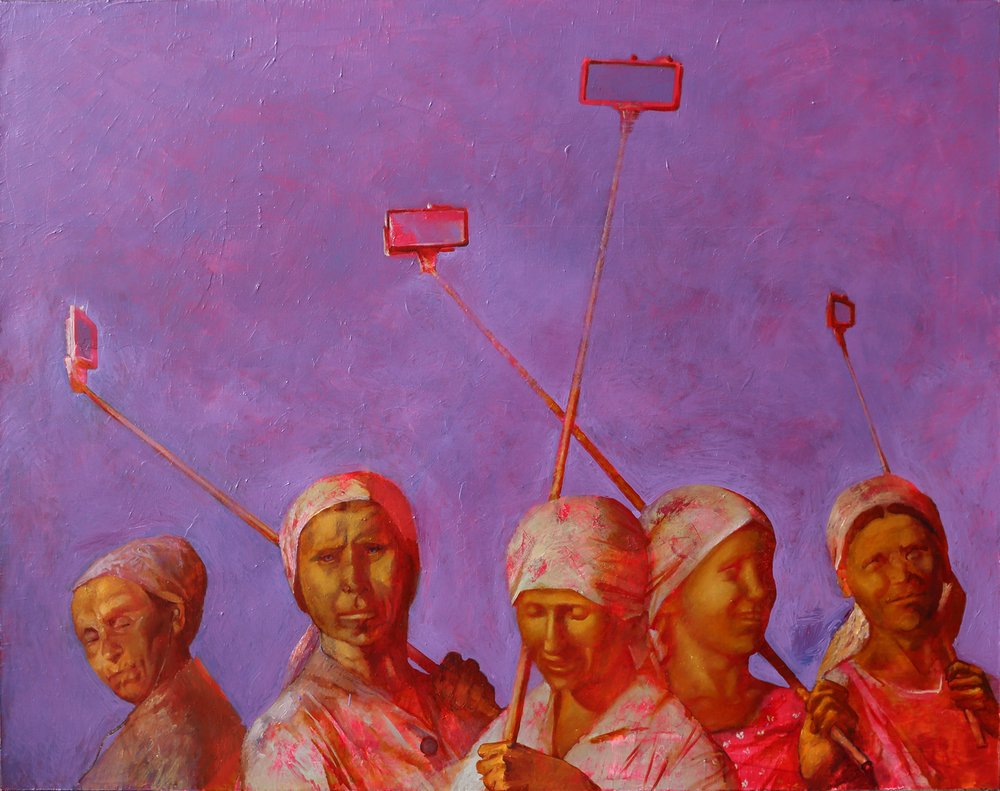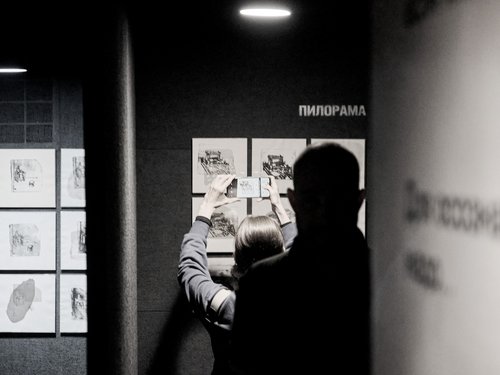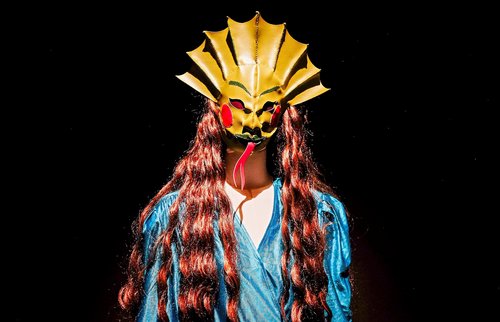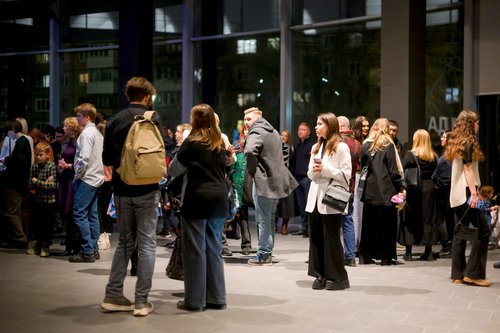Perma-monster: what is contemporary?

Tatiana Necheuhina. Harvest, 2014. Courtesy of the artist and Faberge Museum
An ambitious and curious new exhibition in St Petersburg at the Museum of Fabergé explores contemporary art from Russia’s Perm region, revealing a curious hybrid creature which combines archaic traditions, Soviet realism, the avant-garde, and contemporary art practices.
The Fabergé Museum in St Petersburg, opened in 2013 by Russian billionaire Viktor Vekselberg, has recently been focussing on contemporary art from different regions of Russia. Supported by the oligarch’s Link of Times Foundation, a project called ‘Open World’ is a suite of regional survey shows and the latest iteration currently on view is dedicated to art from Perm.
Ostensibly it is a contemporary art show, but the result is a curious animal, a chaotic assemblage of dissimilar styles and forms, from the avant-garde to socialist realism, naïve wood carvings and psychedelic allusions to surrealism. Spread across two floors, the exhibition, starts on the ground floor with a kind of prologue. Here you find bird-like idols and ancient belt-plates, old architectural plaques and panels decorated with lizards and human-elks all dating from the sixth to the thirteenth centuries, and which set the tone of this exhibition. On the ground floor they are placed in a dialogue with recent paintings by Andrian Bersenev (b. 1963), a native of the Perm region and professor at the Academy of Arts in St Petersburg specialising in Komi-Permyak folklore, including works he produced over the past decade, including his ‘Visions on Glyadenovo Hill’ (2014), ‘The White-Eyed Perm Chud’ (2014) and ‘Song of the Stars’ (2025) all set in carved frames with Slavic sirins and zoomorphs reminiscent of traditional animal sculptures from Perm.
Elsewhere are Evgeny Shirokov’s (1931–2017) ‘Veteran’ (1970), military propaganda posters by Viktor Oreshnikov (1904–1987), a Perm-Leningrad socialist realist and former rector of the Repin Institute, and austere Cézannist paintings by Timofey Kovalenko (1930–2008). Here ‘contemporary’ includes a dedication to the 80th anniversary of Russia’svictory in the Great Patriotic War. In other works, you find a line of continuity from the Russian avant-garde from the cubo-futurism of Pyotr Subbotin-Permyak (1886–1923) to ‘Expositions’ (2013) by Olga Subbotina (b. 1957), whose textile Christs that reference Perm folk wooden religious sculptures, seem to trample the ‘Black Square’.
The art on display throughout the second-floor seals these first impressions of this ‘Perm retrospective’ as a sweeping panoptic blanket of a show. There is the visual archaism of Nikolai Khromov (1949–2008), Maxim Titov’s (b. 1980) homage to the tradition of icon-painting, the bland formal experiments of Igor Novikov (b. 1961) and Maria Kolyvanova (b. 1986), the naïve art of radiologist Rudolf Tyurin (1939–2008) and visually impaired artist Mansur Zakirov (1968–2004), as well as dedications to impresario Sergei Diaghilev, writer Boris Pasternak and, for some reason, Wolfgang Amadeus Mozart. It is all about the past rather than the present, and there is a sense that artists who are genuinely working in the field of contemporary art beyond the traditional media are represented here only because they are well known figures in St Petersburg and it would be odd not to show them.
Artists from Perm have long enjoyed visibility in St Petersburg where until recently one could even refer to a Perm artistic diaspora in the city. Some became artists while there, others had already matured back in their hometowns, some eventually inhabiting the artistic life of both cities. Sergei Denisov (Denikin) (b. 1963) moved from Perm to St Petersburg in 1986. From the early 1990s his collages and objects, consisting of herbaria and entomological finds, translucent plates of mica, plexiglass and resin, botanical illustrations and pages from anatomical atlases, have been well known to the St Petersburg art going public. In the exhibition you see his series of paintings ‘War of the Worlds’ (2007), fragile and lyrical, sometimes clumsy hybrids of the technological and the living. Although Denikin has long been living in St Petersburg where he is an integral part of the local art scene, he also continues working with the Perm context. In 2022, addressing memories of growing up, he exhibited work at the PERMM museum show called ‘Following (along) the Ant Trail’ – a pseudo-scientific laboratory in which blades of grass, dandelion inflorescences and poplar fluff fibres found new life, manifesting the beauty of rebirth and strength in vulnerability.
Objects by Vadim Mikhailov (b. 1979) also find a second life. Mikhailov covers clothing, furniture, carpets and toys with primer, oil paint, gesso, then, occasionally decorating them with lace and wire, he scratches images onto the resulting dark viscous background: folkloric and biblical figures, popular culture heroes, and more often chthonic deities born from his own mythology, as in ‘Death, Thistle and Underground Bird’ (2024). Mikhailov formed his artistic langauge long before he moved to St Petersburg, as a graduate of the Institute of Culture in Perm he also studied in the studio of artists Olga Subbotina and Mikhail Pavlyukevich (1949–2021) and at the contemporary art school ‘Artpolitika’ under curator Arseny Sergeev, he was at the origins of art group KUB.
Artists Anna Andrzhievskaia (b. 1989) and Asya Marakulina (b. 1988) studied together in a Perm art studio and moved to St Petersburg around the same time in the early 2010s, Andrzhievskaya graduating from the Stieglitz Academy andMarakulina from St Petersburg State University. Both attended the Pro Arte Young Artist School in the city and shared a studio and due to the superficial similarity of their work, at times authorship of their subtle, biomorphic, ironic works on paper was unclear and led to a collaborative project ‘This Is Not Me’ (2020). They would swap sheets of paper, drawing over each other’s work until the authorship was completely mixed up and indistinguishable. Ultimately they could not recall which strokes, lines, and blots in the drawings belonged to whom. Andrzhievskaia’s series ‘Perm-36’ (2013), dedicated to the eponymous Stalinist Gulag camp, was also initially exhibited in St Petersburg and later shown at the PERMM museum and Moscow’s Gulag Museum under the title ‘Fencing System.’
Another artist who has left his mark with immediately recognisable inscriptions not only in Perm, but St Petersburg and other cities around Russia is Ilya Grishaev (b. 1984). He studied at the Perm Humanitarian-Technological Institute, in the icon-painting department of the Theological College, and finally the Pro Arte School. In the 2010s, Grishaev joined the St Petersburg group ‘Sever-7’ (as did Andrzhievskaia, Marakulina and later Mikhailov) and together with Irina Aksenovaquickly set up an artist-run space FFTN, which became a cult venue in St Petersburg. Several years ago Grishaev returned to Perm as a teacher at the Tochka Design School. Grishaev's ornamental flourishes which he scales up from small paper stencils to gigantic metal constructions recall abstract Perm petroglyphs and rock paintings. As a link between the archaic and the contemporary these idiosyncratic works would be perfect for ‘Open World’, but surprisingly they are not included in the show.
Despite the show’s big ambitions, clearly the role call of names above does not fully exhaust the artistic scene of the Kama region, nor is the Perm-St Petersburg artistic exchange limited to just these artists. The first major touring exhibition of Perm art from the PERMM museum collection (an offspring of the Perm cultural revolution, which strangely does not participate in the current Fabergé Museum project) was curated at Winzavod in Moscow by St Petersburg artist and curator Pyotr Belyi. However, one can assume that the curatorial mastermind behind the current exhibition at the Faberge Museum, art critic Vladimir Nazansky (b. 1955), is also knowledgeable about the Perm context.
A former curator at Erarta, an independent contemporary art museum in St Petersburg, Nazansky spearheaded its regional programme of exhibitions ‘Russia in Erarta,’ and he was involved in the organisation of the 2012 show ‘(Un)conditional Reality. New Art of Perm’ and the current Fabergé exhibition ‘Open World’ is conceptually close to it with a similar choice of works. It seems that the Fabergé Museum, once famous for blockbuster exhibitions, is turing itself into a chimera-museum that ironically possibly communicates collective identity, cultural mechanisms and the boundaries of the permissible in today’s Russia far more than a ‘real’ contemporary art exhibition.
Open World. Contemporary Art of Perm Region
St Petersburg, Russia
7 June – 13 July 2025



















